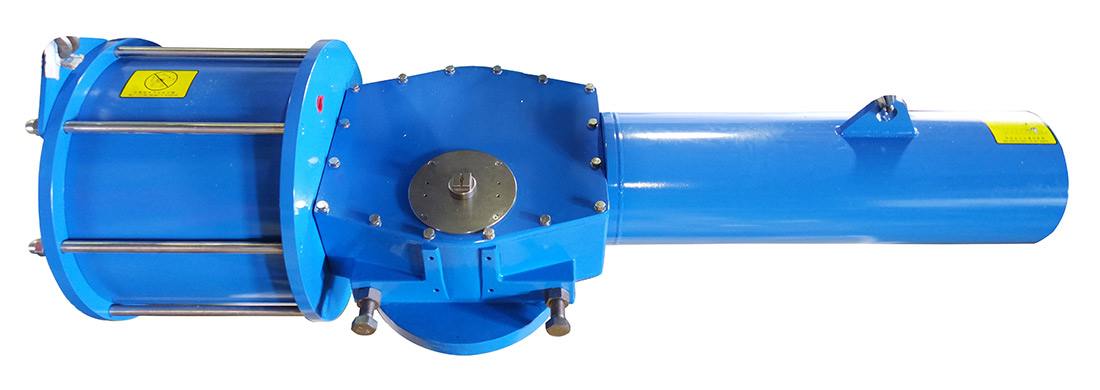News
News
Industry News
您的位置:主页 > News > Industry News >
Classification and characteristics of scotch yoke pneumatic actuator and several domestic actuators
发布时间:2019-01-10 来源:艾德威尔•瑞拓
Scotch yoke pneumatic actuator have many different forms, each of which is widely used in different places because of its own characteristics and advantages. At present, there are four types of pneumatic actuators produced in China: film actuator, piston actuator, long stroke actuator and rolling diaphragm actuator. Thin film actuator and piston actuator are widely used in practical applications.
The pneumatic regulating valve receives the pressure signal from the regulating instrument (the standard signal is 20-100 kpa), controls the opening of the valve, changes the flow rate of the medium flowing through the pipeline, and realizes the adjustment of the adjusted parameters.
The valve is the regulating part of the pneumatic control valve, also known as the regulating mechanism. It contacts the regulating medium directly, and changes the flow area between the valve core and the valve seat under the impetus of the actuating mechanism, so as to achieve the purpose of automatic regulation.
Generally speaking, the valve can cooperate with the pneumatic actuator to form the pneumatic control valve to work normally, improve the quality of regulation, and also need to be equipped with certain auxiliary devices. Valve positioner and handwheel mechanism are commonly used. Valve positioner and pneumatic actuator are used together, and the performance of actuator is improved by negative feedback of valve position, so that actuator can be positioned accurately according to the control signal of regulator. Handwheel mechanism can be considered as a form of bypass. When the regulating system fails, such as power outage, gas source interruption, regulator or or actuator failure, the valve is operated by handwheel mechanism attached to the regulating valve, so as to ensure that production can still proceed normally before the system is repaired. By replacing bypass with handwheel mechanism, the cut-off valves on both sides of the regulating valve can be omitted, the installation pipeline can be shortened and the investment can be saved. However, when the valve itself fails, the handwheel mechanism can not be operated manually. At this time, a bypass valve must be operated manually. Generally, when the nominal diameter of the control valve is more than 80 mm, the handwheel mechanism can be considered to replace the bypass as appropriate.
These are the scotch yoke pneumatic actuator and several execution agencies commonly used in China. For more information about the scotch yoke pneumatic actuator, please visit the Rito official website for consultation. If you have purchase needs, please call.
The pneumatic regulating valve receives the pressure signal from the regulating instrument (the standard signal is 20-100 kpa), controls the opening of the valve, changes the flow rate of the medium flowing through the pipeline, and realizes the adjustment of the adjusted parameters.
Pneumatic control valve is composed of pneumatic actuator and valve. Valve positioner and handwheel mechanism can also be fitted as needed.

The valve is the regulating part of the pneumatic control valve, also known as the regulating mechanism. It contacts the regulating medium directly, and changes the flow area between the valve core and the valve seat under the impetus of the actuating mechanism, so as to achieve the purpose of automatic regulation.
Generally speaking, the valve can cooperate with the pneumatic actuator to form the pneumatic control valve to work normally, improve the quality of regulation, and also need to be equipped with certain auxiliary devices. Valve positioner and handwheel mechanism are commonly used. Valve positioner and pneumatic actuator are used together, and the performance of actuator is improved by negative feedback of valve position, so that actuator can be positioned accurately according to the control signal of regulator. Handwheel mechanism can be considered as a form of bypass. When the regulating system fails, such as power outage, gas source interruption, regulator or or actuator failure, the valve is operated by handwheel mechanism attached to the regulating valve, so as to ensure that production can still proceed normally before the system is repaired. By replacing bypass with handwheel mechanism, the cut-off valves on both sides of the regulating valve can be omitted, the installation pipeline can be shortened and the investment can be saved. However, when the valve itself fails, the handwheel mechanism can not be operated manually. At this time, a bypass valve must be operated manually. Generally, when the nominal diameter of the control valve is more than 80 mm, the handwheel mechanism can be considered to replace the bypass as appropriate.
These are the scotch yoke pneumatic actuator and several execution agencies commonly used in China. For more information about the scotch yoke pneumatic actuator, please visit the Rito official website for consultation. If you have purchase needs, please call.






